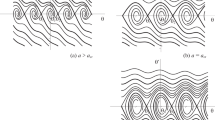Abstract
In this work I propose a mechanism whereby a Watt mechanical governor can be used in the context of electric motor control. The motor considered is the shunt or parallel dc motor, in which flux weakening is used as a speed regulation strategy. Connection of the governorballs to a variable resistor in series with the stator circuit results in automatic flux weakening as the motor speed changes, and this phenomenon can be used to alter the torque-speed characteristics of the motor in the desired manner. After demonstrating the details of this process under the steady state assumption, I construct the dynamic model for the combined motor–governor arrangement. The system is a set of coupled nonlinear differential equations. Linearization about the fixed point yields the conditions for stable operation and also shows the possibility of a Hopf bifurcation. I introduce a self-consistent procedure for finding the characteristics of the limit cycle. The existence of this limit cycle is supported by numerical simulations.










Similar content being viewed by others
References
Dorf, R.C., Bishop, R.H.: Modern Control Systems. Prentice Hall, Upper Saddle River (2008)
Bikdash, M., Kunchitapadam, V., Raghunathan, K., Homaifar, A.: Comparison of quasi bang-bang and sliding mode controls for a dc shunt motor with time delay. Nonlin. Dyn. 23(1), 87–102 (2000)
Yu, J., Chen, B., Yu, H.: Fuzzy-approximation-based adaptive control of the chaotic permanent magnet synchronous motor. Ibid 69(3), 1479–1488 (2012)
Yu, H., Yu, J., Liu, J., Song, Q.: Nonlinear control of induction motors based on state error PCH and energy-shaping principle. Ibid 72(1), 49–59 (2013)
Rattan, S.S.: Theory of Machines, 2nd edn. Tata McGraw Hill, New Delhi (2005)
Krishnan, R.: Electric Motor Drives—Modeling. Analysis and Control. PHI Learning Private Limited, New Delhi (2010)
Blaschke, F.: The principle of field orientation as applied to the new closed loop transvector control for rotating field machines. Siemens Rev. 39(4), 217–221 (1972)
Bhattacharjee, S.: A modified scalar control of an induction motor with applications in traction. IAEME Int. J. Eletrc. Eng. Technol. 3(2), 394–404 (2012)
Takahashi, I., Noguchi, T.: A new quick response and high efficiency control strategy of an induction motor. IEEE Trans. Ind. Appl. 22(5), 820–827 (1986)
Depenbrock, M.: Direct self control of inverter fed induction machine. IEEE Trans. Power Electron. 3(4), 420–429 (1988)
Joshi, K.M.: TOM-Governor, http://joshikandarp.webs.com/apps/documents/categories/show/47891
Chapman, S.J.: Electric Machinery Fundamentals, 4th edn. Mc Graw Hill, New York (2005)
Bhattacharjee, S.: The Electromagnetism of the Induction Motor. Lambert Academic Publishing, Saarbrucken (2013)
Denny, M.: Watt steam governor stability. Eur. J. Phys. 23(3), 339–351 (2002)
Maxwell, J.C.: On governors. Proc. R Soc. Lond. 16, 270–283 (1868)
Vyshnegradskii, I. A.: Indirect-action governors, Izvestiya SPB Prakticheskogo Technologicheskogo Inst. pp. 1–48 (1878)
Pontryagin, L.S.: Ordinary Differential Equations. Addison-Wesley, Reading (1962)
Al-Humadi, A., Kazarinoff, N.D.: Hopf bifurcation in the Watt steam engine. Bull. Inst. Math. Appl. 21, 133–136 (1985)
Sotomayor, J., Mello, L.F., Braga, D.C.: Bifurcation analysis of the Watt governor system. Comput. Appl. Math. 26, 19–44 (2007)
Sotomayor, J., Mello, L.F., Braga,D.C.: Stability and Hopf bifurcation in the Watt governor system, http://arxiv.org/abs/math.0604177v1 (2006)
Sotomayor, J., Mello, L.F., Braga, D.C.: Stability and Hopf bifurcation in a hexagonal governor system. Nonlinear Anal. Real World Appl. 9(3), 889–898 (2008)
http://www.railelectrica.com/traction-motor/dc-series-motor-as-traction-motor/
Acknowledgments
I am grateful to Kishore Vaigyanik Protsahan Yojana (KVPY), Government of India, for a generous Fellowship. I would also like to mention that the present work is an extension of a summer project done in May–June 2013 at IIT Kharagpur under Prof. Krishna Kumar.
Author information
Authors and Affiliations
Corresponding author
Rights and permissions
About this article
Cite this article
Bhattacharjee, S. On mechanical governors for electric motors. Nonlinear Dyn 77, 153–168 (2014). https://doi.org/10.1007/s11071-014-1281-9
Received:
Accepted:
Published:
Issue Date:
DOI: https://doi.org/10.1007/s11071-014-1281-9




